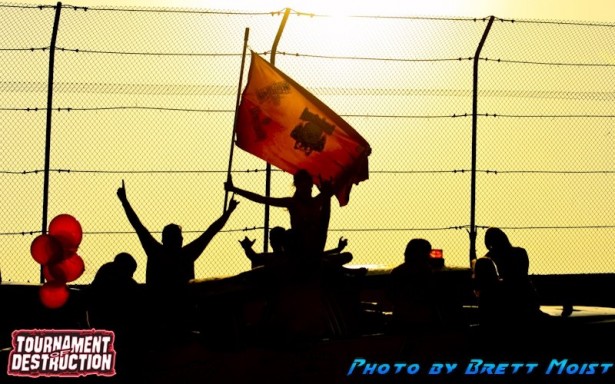I like statistics. I love reading how Vegas computes its NFL lines, enjoy pouring over the weekend box office totals each Monday morning and, while I hate watching baseball, am fascinated by the myriad stats that are now available to fans. In the latter case, it’s not simply OPS and WHIP, but FIP, WAR and BABIP too.
The joy I derive from statistics comes from the different perspectives they give me and the (hopefully) more clear understanding I have of the ways things work after looking at them.
For the last two years, I’ve pondered the concept of creating statistics for the TDA. When I first mentioned this to Jason Twite, he snorted, laughed, rolled his eyes, choked, frowned and gasped simultaneously. Apparently to most people, especially the fans and the folks at Speed Channel, the demos are about crashing cars, fist fights in the pits and, maybe, if everyone’s lucky, something catching on fire. They are not about subtlety and nuance and they sure as hell don’t involve statistics unless ‘hill billy awesomeness’ could be miraculously quantified.
And I beg to differ.
As I get closer to the sport of Team Demolition Derby, I find myself more and more interested in the technique displayed in the races and the near chess matches that unfold on the track. Sure, there are drivers who just want to hit stuff, but there are also drivers who talk glowingly about the mistakes that other drivers make when they expose their driver’s side cowls from around a tire and how a simple bump can occasionally inflict more damage than a 45 mile an hour head on collision. Watching former Killer Bees teammates Ron Johnston and “Speedy” Steve Vollbrecht target the back wheels of their opponents’ cars gives me a strange satisfaction. I know they are picking their hits carefully and there is a beauty to that.
Wanting to understand more about the sport and to see if I could get a more crystallized picture of who did what and what impacted winning, I began contemplating the concept of creating statistics for the TDA. And it’s a more difficult process than one might initially imagine. First, there’s the matter of coming up with something to count and then there’s the matter of going through the videos of the races and accurately counting said statistic.
My initial thought was a statistic for ‘kills’. Every time a driver took out another driver—think Bad Company’s Jason Ritacco on Reckoning’s Steve Gursky Jr. First Night this year—that driver would get credited for a ‘kill’. The problem with this, of course, comes with the definition of ‘take out’. Statistics are only as good as the acts that they represent and if that act is filled with ambiguity, the statistics are thusly rendered meaningless.
When one of Full Throttle’s crushers blasted Bad Company’s Joe Snow in turn 2 of their race Fifth Night and Snow sat for a couple of minutes before rejoining the fray, would that constitute a ‘kill’? For that matter, when Snow tried to hit Stranglehold’s Wally Hartung Fourth Night and missed, crashing into the wall, would that? Would there need to be a special place in the statistic for ‘suicides’?
There were so many variables at play, it didn’t seem like a good statistic to begin with. I needed a starting point that had as little subjectivity as possible; something where no one could raise their voice and complain that the numbers were fudged. So I went with wins and losses.
Because the TDA uses a points system to declare the season champions, no one really thinks about the actual wins and losses or, for that matter, ever really counts them.
So I did.
And looking over the results, one number jumped out at me: Reckoning’s 12 wins. : In 2011, they won twice as many races as anyone else in the league. Reckoning won 12 races, Orange Crush and Mean Green Machines came in second with 6 wins apiece.
1) Reckoning 12-2
2) Orange Crush 6-4
2) Mean Green Machines 6-4
4) Full Throttle 5-5*
5) Stranglehold 2-5
5) Bad Company 2-5
7) Seek-N-Destroy 1-5
7) Damage, Inc 1-5
* Full Throttle’s win/loss record here and throughout this column reflects a loss to Mean Green Machines in Fourth Night.
Knowing the win/loss totals for the teams, I decided to then determine each team’s strength of schedule (which teams raced the opponents with the most wins, which teams raced the least). I figured it’d be enlightening to see if any numbers stood out once I’d done so.
To calculate each team’s strength of schedule, I determined the winning percentage for each team; for example, Damage, Inc’s winning percentage is 16% or .16; meaning at the rate they raced in 2011, they would win 16 out of every 100 races that they raced. I then made a list of which teams raced one another and, for each individual team, added together the total winning percentages of the teams they faced and divided that number by the total number of races the individual team had raced. The result of that was insight into which teams faced the strongest competition this past year.
The answer, surprisingly, was Full Throttle. The teams that Full Throttle faced had, on average, a 57% winning percentage.
I say ‘surprisingly’ because the expectation for this statistic is always that the worst teams would have the hardest schedule and the best teams would have the easiest schedule. (There are about three very lengthy and detailed explanations for this that I’m not going to bore anyone with here. Just trust me when I say this).
There are two very notable exceptions to this expected outcome: Full Throttle tied for second place on the season and had the hardest schedule of anybody in the league and Bad Company won just two races on the season despite having the third easiest schedule of any team.
Think about that: Full Throttle had the hardest schedule in the league and came in tied for second! That shouldn’t be! If that doesn’t make Full Throttle inaugural season in the TDA more impressive, I don’t know what will.
On the other hand, Bad Company’s disappointing season just got that much more so; not only did they go 2-5 on the year, but they did so while facing off against a collection of teams that didn’t manage to even win half their races on average.
OPPONENTS’ WINNING PERCENTAGES
(.57 means that Full Throttle’s opponents won 57% of their races; 57 out of 100)
1) Full Throttle .57
2) Seek-N-Destroy .56
3) Stranglehold .55
4) Damage, Inc .54
5) Orange Crush .52
6) Bad Company .47
7) Mean Green Machines .46
8) Reckoning .38
The next logical step was to see how close to expected wins/losses teams came.
Knowing that Full Throttle’s opponents won 57% of their races, that meant that Full Throttle would have only been expected win 43% of their races. They didn’t. They won 50% of their races, a 7% improvement above expectations.
I ran through and compared the teams’ actual winning percentages against their expect winning percentage and found more interesting bits of information.
Orange Crush, Mean Green Machines and Full Throttle all tied for second place in 2011. However, Orange Crush won 12% more races than would be expected while Full Throttle weighed in at 7% more and Mean Green Machines came in a 6% more.
Bad Company and Stranglehold tied in the standings too, both teams finishing with 2-5 records, but Bad Company won 24% less races than expected, while Stranglehold only won 16% less.
TEAMS’ DIFFERENCE FROM EXPECTED WIN PERCENTAGE
(+24% means that Reckoning won 24% more of their races than would have been expected, based upon their opponents’ records)
1) Reckoning +24%
2) Orange Crush +12%
3) Full Throttle +7%
4) Mean Green Machines +6%
5) Stranglehold -16%
6) Bad Company -24%
7) Seek-N-Destroy -28%
8) Damage, Inc -30%
Interested in learning which teams’ wins came against the best teams and which teams’ losses came against the worst teams, I decided to expand my stats still further. I used the same methodology I did to find out the strength of schedule, only I did so here after separating the teams’ opponents into the teams they beat and the teams they lost to.
Only one team in the league can boast that the average winning percentage of the teams they beat was over .500. That team is—any guesses?—Stranglehold. I didn’t expect it either. They had two wins on the season and both were against quality teams. Their opponents, Full Throttle and Orange Crush had an average winning percentage of 55%.
What makes this information about Stranglehold’s wins against Full Throttle and Orange Crush all the more fascinating is that Stranglehold’s five losses came against the weakest collection of opponents in the league. This is what will happen when you lose to both Bad Company and Damage, Inc in one season.
On the other side of things was Seek-N-Destroy. Seek-N-Destroy was a far more typical team in that the only team they beat—Damage, Inc—was dreadful and the teams they lost to had the second highest winning percentage in the league.
QUALITY OF WINS
(.55 means that the teams Stranglehold beat won 55% of their races; the higher the number, the tougher the wins)
1) Stranglehold .55
2) Orange Crush .49
3) Full Throttle .45
4) Reckoning .35
4) Mean Green Machines .35
6) Damage, Inc .29
7) Bad Company .23
8) Seek-N-Destroy .16
QUALITY OF LOSSES
(.69 means that the teams Full Throttle lost to won 69% of their races; the higher the number, the tougher the losses)
1) Full Throttle .69
2) Seek-N-Destroy .64
3) Bad Company .63
4) Mean Green Machines .61
5) Reckoning .60
5) Damage, Inc. .60
7) Orange Crush .56
8) Stranglehold .55
None of these numbers or statistics changes anything, but it was fascinating for me to learn how much of an uphill battle Full Throttle had this year, how Mean Green Machines’ victories tended to come against bad teams and their losses to good teams and how Stranglehold had the exact opposite problem: they couldn’t beat the bad teams, but could the good.

